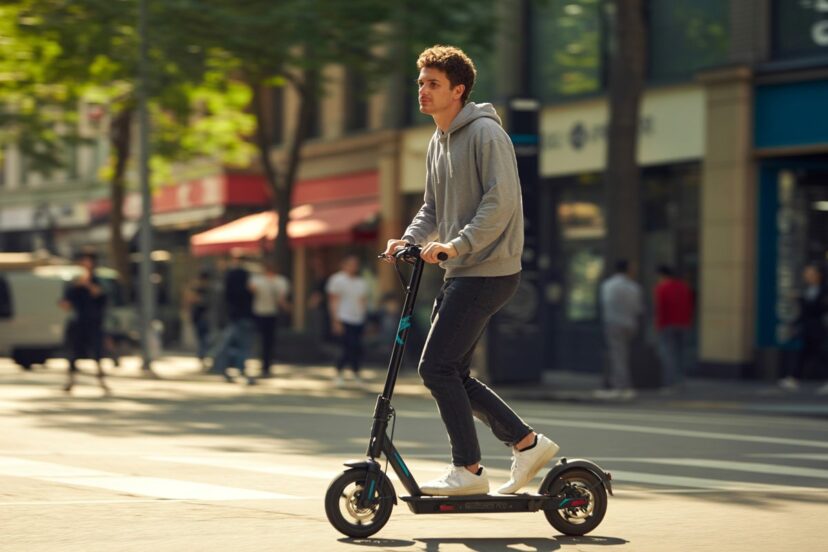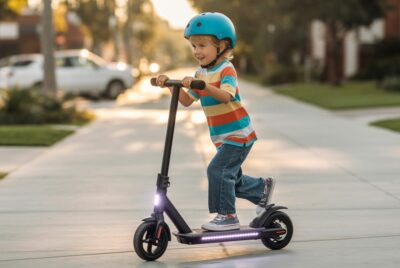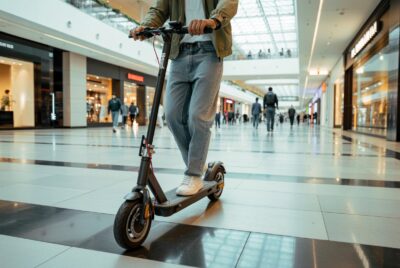The Quietest Electric Scooters in the Market
*We may earn a commission for purchases made using our links. Please see our disclosure to learn more.
The gentle hum of an electric motor barely audible above the whisper of wheels on pavement – this is the hallmark of today’s quietest electric scooters. As urban mobility evolves and noise pollution becomes an increasing concern, the demand for silent transportation solutions has never been higher. Whether you’re commuting through residential neighborhoods in the early morning hours or simply prefer a peaceful ride, finding the right quiet electric scooter can transform your daily travel experience.
Modern electric scooters have come a long way from their louder predecessors. Advanced motor technology, improved design engineering, and innovative noise-dampening features have created a new generation of whisper-quiet personal transportation devices that respect both riders and the communities they travel through.
“The future of urban mobility lies not just in efficiency and sustainability, but in harmony with our communities. A truly great electric scooter should enhance the urban experience without disrupting the peace that makes city life livable.”
— Urban Mobility Research Institute, 2024
Key Takeaways
- Motor type matters most: Brushless DC motors with proper magnetic shielding produce significantly less noise than traditional brushed motors
- Speed vs. silence trade-off: The quietest scooters typically operate at moderate speeds (15-20 mph) to minimize wind and mechanical noise
- Build quality impacts noise levels: Premium materials, precision engineering, and quality bearings contribute to smoother, quieter operation
- Maintenance affects performance: Regular cleaning, lubrication, and proper tire pressure help maintain optimal quiet operation
- Price range varies widely: Quality quiet electric scooters range from $300 to $2,000, with sweet spots around $600-$1,200 for most users
Recommended Quietest Electric Scooters
Segway Ninebot Max G3 Electric Scooter
The Segway Ninebot Max G3 is one of the quietest electric scooters designed for riders who value both silence and performance. Featuring a powerful 2000W peak motor, a top speed of 28 mph, and a max range of 50 miles, this scooter delivers smooth, noise-free rides perfect for city commutes or long-distance travel. With dual hydraulic suspension, advanced stability systems, and self-sealing 11-inch tires, the G3 ensures comfort and safety while keeping road noise at a minimum. Its fast charging system (3.5 hours standard, 2.5 hours with optional DC charger) makes it ideal for daily use. Certified under UL-2272 safety standards, it’s a reliable option for adults and teens seeking premium quality and peace of mind.
When searching for the quietest electric scooters, the Segway Ninebot Max G3 consistently stands out. Engineered with noise-reducing technology and premium build quality, this scooter offers riders a near-silent commuting experience without sacrificing speed or power. Its 2000W peak motor provides smooth acceleration up to 28 mph, while the dual hydraulic suspension system and self-sealing 11-inch tubeless tires minimize vibration and road noise.
- Quiet Ride: Low-noise motor and smooth suspension make it one of the quietest electric scooters for urban commutes.
- Long Range: Up to 50 miles per charge, ideal for extended rides without frequent recharging.
- Comfort & Stability: Dual hydraulic suspension and self-sealing tires absorb shocks for a smoother, quieter journey.
- Premium Price: Higher cost compared to entry-level scooters.
- Heavy Frame: Weighs more than lightweight commuter models, less portable.
- Non-Returnable: Limited return options due to hazardous material regulations.
NIU KQi3 Pro Electric Scooter
The NIU KQi3 Pro Electric Scooter is designed for urban commuters who want a reliable, smooth, and efficient ride. With a 31-mile range and a top speed of 20 mph, this scooter balances performance with practicality. Its foldable frame makes it easy to carry and store, while the pneumatic tires ensure a comfortable ride on various terrains. Whether you're heading to work or cruising around town, the KQi3 Pro delivers a dependable and enjoyable experience.
If you’re searching for one of the quietest electric scooters without breaking the bank, the NIU KQi3 Pro is worth considering. This model combines affordability with low-noise operation, making it a solid choice for students, young professionals, and budget-conscious commuters.
- Long Range: Travels up to 31 miles on a single charge, ideal for daily commuting.
- Smooth Ride: Pneumatic tires and ergonomic grips provide comfort on different surfaces.
- Portable Design: Foldable frame allows for easy storage and transport.
- Limited Speed: Maxes out at 20 mph, which may feel slow for some riders.
- Fixed Handlebar: Lacks height adjustability for personalized comfort.
- Mixed Reviews: Some users report durability concerns over time.
Gotrax Gmax Ultra Electric Scooter
The Gotrax Gmax Ultra is a premium commuting scooter built for riders who want long-distance performance and quiet operation. Powered by a 500W motor with a 20 mph top speed and up to 45 miles of range, this model is designed for serious daily commuters. Its 10-inch pneumatic tires absorb road vibrations, reducing noise for smoother, quieter rides. Featuring a UL-2272 certified LG battery, cruise control, and a digital display, it’s both safe and easy to operate. Added anti-theft protections, including an electric code lock and built-in cable lock, make it a reliable choice for urban riders.
If you’re looking for one of the quietest electric scooters for commuting, the Gotrax Gmax Ultra strikes a balance between silence, comfort, and range. Its 10-inch pneumatic tires absorb shocks and reduce vibrations, giving riders a smoother, noise-free experience on city streets. Unlike budget scooters, the Gmax Ultra is equipped with a premium LG battery that delivers up to 45 miles per charge—ideal for long-distance commuters.
- Quiet & Smooth Ride: Pneumatic tires and stable frame reduce noise and vibration, making it one of the quietest electric scooters in its class.
- Long Range: Up to 45 miles per charge with a high-quality LG battery.
- Security Features: Built-in electric code lock and cable lock for double anti-theft protection.
- Heavier Build: Less portable compared to smaller commuter scooters.
- Moderate Speed: Capped at 20 mph, slower than some higher-end models.
- Tire Maintenance: Pneumatic tires require regular inflation to maintain performance.
Hiboy S2 Pro Electric Scooter
The Hiboy S2 Pro and S2 Max are commuter-friendly electric scooters built with comfort and quiet performance in mind. Featuring a 500W brushless hub motor, these scooters reach speeds of up to 19 mph with ranges from 25 to 40.4 miles depending on the model. The 10-inch solid tires and rear dual shock absorbers provide a smooth, stable ride while keeping noise levels low, making them some of the quietest electric scooters in their price range. Additional features include a foldable design for portability, ultra-bright headlights for safety, and app connectivity to lock your scooter or customize ride settings.
The Hiboy S2 Pro and S2 Max are standout options for commuters searching for the quietest electric scooters without overspending. Powered by a reliable 500W brushless motor, they deliver whisper-quiet rides at speeds up to 19 mph. The Pro model offers a 25-mile range, while the Max extends to an impressive 40.4 miles, giving riders flexibility based on daily needs.
- Quiet & Smooth Ride: Solid tires with dual rear suspension reduce noise and absorb shocks for comfortable commuting.
- App Connectivity: Hiboy app allows locking, acceleration adjustments, and braking customization.
- Portable Design: Foldable frame makes it easy to carry and store in compact spaces.
- Moderate Speed: Max speed capped at 19 mph, slower than premium models.
- Weight Limit: Supports up to 220 lbs, less than higher-capacity scooters.
- Solid Tires: While maintenance-free, they provide less cushioning than pneumatic tires.
Understanding Electric Scooter Noise Sources
The journey toward finding the perfect quiet electric scooter begins with understanding where noise originates. Unlike the obvious engine roar of gas-powered vehicles, electric scooter noise comes from multiple subtle sources that, when combined, can create an unexpectedly loud riding experience.
Motor noise represents the primary sound source in most electric scooters. Traditional brushed motors generate noise through physical contact between carbon brushes and the rotating commutator. This mechanical friction creates not only the characteristic whining sound many associate with electric motors but also contributes to long-term wear that can increase noise levels over time.
Brushless motors, by contrast, eliminate this mechanical contact entirely. Using magnetic fields to control rotation, these advanced motors can operate with remarkable quietness. The best brushless motors incorporate magnetic shielding and optimized winding patterns that further reduce electromagnetic noise – the high-frequency humming that can be particularly noticeable in quiet environments.
Wheel and bearing noise often goes unnoticed until you experience a truly quiet motor. Low-quality bearings create grinding sounds, while precision ball bearings allow wheels to spin freely with minimal friction noise. The difference becomes particularly apparent during coasting, when motor noise disappears entirely and wheel mechanics take center stage.
Tire noise varies dramatically between solid and pneumatic options. Solid rubber tires eliminate the road noise that air-filled tires can amplify, but they may transmit more vibration noise through the scooter’s frame. Pneumatic tires with optimized tread patterns can actually reduce overall noise by providing better shock absorption, though they introduce the possibility of air compression sounds during sharp acceleration or braking.
The Science Behind Quiet Operation
Modern quiet electric scooters employ sophisticated engineering principles to minimize noise generation at its source. Understanding these technologies helps explain why some scooters cost significantly more than others while delivering genuinely quieter performance.
Magnetic motor technology represents the current pinnacle of quiet electric motor design. These systems use precisely arranged permanent magnets and optimized electromagnetic fields to create rotation with minimal mechanical friction. The result is not just quieter operation, but also improved efficiency and longer motor life.
Advanced motor controllers play a crucial role in noise reduction by managing power delivery smoothly. Cheap controllers create sudden power surges that cause motors to work harder and generate more noise. Premium controllers use sophisticated algorithms to provide seamless acceleration and deceleration, maintaining optimal motor efficiency and minimal noise throughout the entire speed range.
Vibration isolation systems separate noise-generating components from the frame and deck that riders stand on. High-end scooters incorporate rubber dampeners, precision-machined mounting points, and even specialized foam materials that absorb vibrations before they can transmit through the scooter’s structure to create audible noise.
Frame design significantly impacts noise transmission. Solid construction reduces rattling and vibration, while strategic material choices can actually dampen sound transmission. Some manufacturers use hollow frame sections filled with sound-dampening materials, while others employ specialized aluminum alloys that naturally resist vibration transmission.
Practical Considerations for Quiet Riding
Achieving maximum quietness from any electric scooter requires attention to maintenance and riding technique. Even the quietest scooter can become noisy without proper care, while good maintenance can keep budget models operating more quietly than neglected premium alternatives.
Regular bearing maintenance keeps wheels spinning freely and quietly. Most scooters use sealed bearings that require minimal maintenance, but periodic cleaning and occasional lubrication can prevent the grinding noises that develop as bearings wear or collect debris.
Tire pressure significantly affects noise levels in pneumatic-tired scooters. Under-inflated tires create more rolling resistance, forcing motors to work harder and generate more noise. Over-inflation can cause tires to transmit more road vibration. Finding the optimal pressure – usually specified by the manufacturer – maintains the best balance of performance and quiet operation.
Proper folding mechanism maintenance prevents the rattling and creaking that can make even quiet motors sound loud. Regular lubrication of pivot points and periodic tightening of bolts keeps folding mechanisms operating smoothly and silently.
Riding technique influences noise levels more than many riders realize. Smooth acceleration and gradual braking allow motors to operate in their quietest ranges. Aggressive starts and sudden stops force motors to work outside their optimal efficiency zones, increasing both noise and battery consumption.
Environmental Impact and Community Considerations
The push toward quieter electric scooters reflects growing awareness of noise pollution’s impact on urban quality of life. Studies consistently show that transportation noise affects sleep patterns, stress levels, and overall community satisfaction. Quiet electric scooters represent one solution to the broader challenge of creating more livable cities.
Early morning and late evening riding particularly benefit from quiet operation. Many urban areas have noise ordinances that technically apply to all motorized vehicles, though enforcement varies. Choosing a genuinely quiet electric scooter demonstrates consideration for neighbors and helps build community acceptance of personal electric vehicles.
Wildlife considerations extend beyond urban environments. Quiet electric scooters allow riders to observe birds and small animals without the disturbance that louder vehicles create. This makes them particularly appealing for recreational riding in parks and nature areas where noise restrictions may apply.
The psychological benefits of quiet operation extend to riders themselves. Reduced motor noise allows better awareness of surrounding traffic and pedestrians, improving safety. Many riders report that quiet scooters feel more relaxing and less stressful to operate, particularly during longer commutes.
Technology Trends and Future Developments
The electric scooter industry continues advancing toward ever-quieter operation through emerging technologies and refined engineering approaches. Understanding these trends helps predict which features will become standard and which current premium technologies may become more affordable.
Magnetic levitation bearing systems, borrowed from high-speed rail technology, promise virtually silent wheel operation. While currently expensive, these systems eliminate all physical contact in wheel bearings, removing a significant noise source entirely.
Active noise cancellation, familiar from premium headphones, is beginning to appear in high-end electric scooters. These systems use microphones to detect motor and road noise, then generate precise sound waves that cancel unwanted frequencies. While still experimental, early implementations show promising results for further noise reduction.
Solid-state motor controllers eliminate the switching noise that traditional electronic speed controllers can create. Using advanced semiconductor technologies, these controllers provide perfectly smooth power delivery while operating in complete silence themselves.
Advanced tire compounds and tread patterns continue evolving to balance performance, durability, and noise reduction. Some manufacturers are experimenting with foam-filled tires that combine the noise benefits of solid tires with improved shock absorption similar to pneumatic designs.
Making the Right Choice for Your Needs
Selecting the quietest electric scooter requires balancing noise performance against other factors like range, speed, portability, and budget. Understanding your specific priorities helps identify which compromises make sense for your situation.
Commuting distances influence the importance of various quiet features. Short urban trips may prioritize maximum quietness over range or speed, while longer commutes might accept slightly higher noise levels in exchange for better performance or battery life.
Storage and portability needs affect scooter selection significantly. Some of the quietest motors are larger and heavier than noisier alternatives. Folding mechanisms, while convenient, can introduce potential noise sources through increased mechanical complexity.
Budget considerations require realistic expectations about quiet performance. While genuinely quiet electric scooters are available across price ranges, the quietest models typically command premium prices due to advanced motor technology and precision manufacturing requirements.
Local regulations and usage environments shape the practical importance of quiet operation. Dense residential areas with strict noise ordinances make quiet operation essential, while industrial or commercial districts may prioritize other performance characteristics.
Maintenance for Sustained Quiet Operation
Maintaining optimal quiet performance requires understanding how different maintenance practices affect noise levels over time. Even premium quiet electric scooters can become noisy without proper care, while good maintenance extends the quiet operation period significantly.
Motor maintenance primarily involves keeping cooling vents clear and ensuring proper electrical connections remain tight. Brushless motors require minimal direct maintenance, but clean operation depends on preventing debris accumulation that can interfere with cooling or create vibration.
Cleaning practices significantly impact long-term noise levels. Regular removal of dirt, leaves, and debris prevents these materials from interfering with moving parts or creating vibration sources. Special attention to wheel wells and motor housing ventilation keeps components operating smoothly.
Lubrication schedules vary by component and usage intensity. While sealed bearings typically require minimal maintenance, folding mechanisms, steering joints, and brake pivots benefit from periodic lubrication with appropriate materials.
Storage practices affect noise performance indirectly through component preservation. Protecting scooters from moisture prevents corrosion that can increase friction in moving parts. Temperature extremes can affect battery performance and motor efficiency, indirectly impacting noise levels.
Conclusion
The quest for the quietest electric scooter reflects broader changes in how we think about urban mobility and community responsibility. Today’s best quiet electric scooters prove that personal transportation can be both efficient and considerate, delivering the performance modern commuters need without disturbing the peace that makes urban life enjoyable.
Whether you’re drawn to quiet electric scooters for early morning commutes, consideration for neighbors, or simply personal preference for peaceful travel, the current market offers compelling options across various price points and performance levels. The key lies in understanding your specific needs and choosing a scooter that balances quiet operation with other essential features.
As technology continues advancing and community awareness of noise pollution grows, quiet electric scooters will likely become not just a premium option, but an expected standard. For forward-thinking riders ready to embrace this quiet revolution in personal mobility, the time to make the switch has never been better.
The investment in a quality quiet electric scooter pays dividends not just in personal satisfaction, but in contributing to more peaceful, livable urban environments for everyone. In choosing quiet operation, riders become part of the solution to urban noise pollution while enjoying the practical and emotional benefits of peaceful, efficient transportation.
Frequently Asked Questions
Q: How much quieter are the best electric scooters compared to average models?
A: Premium quiet electric scooters typically operate 10-15 decibels quieter than budget models, which represents a significant difference in perceived loudness. While average scooters might produce 60-70 decibels at normal operating speeds, the quietest models can operate as low as 45-55 decibels – roughly equivalent to a quiet library versus normal conversation levels.
Q: Do quieter electric scooters sacrifice performance for noise reduction?
A: Modern quiet electric scooters often perform better than noisier alternatives because the same engineering precision that reduces noise also improves efficiency. However, some trade-offs exist – the quietest models may have slightly lower top speeds (15-20 mph vs 25+ mph) and prioritize smooth acceleration over rapid acceleration.
Q: Will a quiet electric scooter stay quiet over time with regular use?
A: Quality quiet electric scooters maintain their low noise levels for years with proper maintenance. The key factors are choosing a model with quality bearings and brushless motors, followed by regular cleaning and appropriate lubrication. Budget models may become noisier more quickly due to component wear.
Q: Are solid tires or pneumatic tires quieter on electric scooters?
A: The answer depends on riding conditions and scooter design. Solid tires eliminate air compression noise and puncture-related issues, making them consistently quiet. Pneumatic tires can be quieter on rough surfaces due to better shock absorption, but may create more noise on smooth pavement. The best choice depends on your typical riding environment.
















